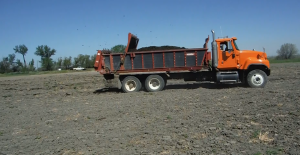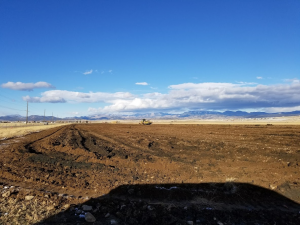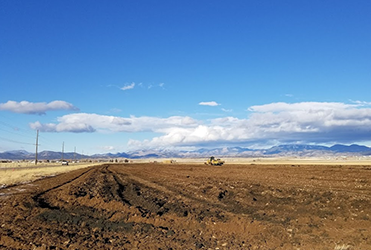Sludge vs. Biosolids
The Department of Environmental Quality (DEQ) states in their Guidance for Land Application of Municipal Biosolids, “biosolids management is a complex endeavor that requires strategic planning”. With this in mind, this article will briefly overview some of the terms and regulations that govern lagoon sludge disposal and beneficial reuse.
The term “sewage sludge” has been commonly used in our industry because of its wide recognition, regulatory definition, and consistency with some Environmental Protection Agency (EPA) guidance documents. The term “biosolids” now appears in many publications as it has become a more common replacement for the term “sewage sludge”. However, these terms are not always interchangeable. The engineering industry has adopted a policy of encouraging the use of the word biosolids for sludge that has undergone treatment and meets federal and state standards for beneficial use.
The EPA defines Biosolids as: “Nutrient-rich organic materials resulting from the treatment of domestic sewage in a treatment facility. When treated and processed, these residuals can be recycled and applied as fertilizer to improve and maintain productive soils and stimulate plant growth.” The EPA further defines the difference between biosolids and sludge as: “Biosolids are treated sewage sludge. Biosolids are carefully treated and monitored and must be used in accordance with regulatory requirements.”

Land Application of Biosolids
EPA and State Regulations
The EPA and some states, such as Idaho, have governance over the disposal and beneficial reuse of biosolids from wastewater treatment lagoons. The intent of these State and Federal programs is to ensure that biosolids are used or disposed of in a way that protects both human health and the environment.
The Federal biosolids regulations are contained in 40 CFR Part 503. Biosolids for beneficial reuse must meet these strict regulations and quality standards. These regulations contain numerical limits, for metals in biosolids, pathogen reduction standards, site restrictions, crop harvesting restrictions and monitoring, record keeping and reporting requirements for land applied biosolids as well as similar requirements for biosolids that are surface disposed or incinerated. It is also important to note that some biosolids may contain constituents that are subject to additional federal regulations.
There is a maze of regulations, but for simplicity of this article, we will pair it down to an Idaho DEQ quote “EPA is the permitting and enforcement authority for 40 CFR Part 503. In many instances, compliance with federal biosolids management requirements may result in compliance with state law as well. However, the state and federal regulatory programs are operated independently, and the regulated community must ensure compliance with both.”

Incorporating Biosolids Into Soil for Land Application Reuse
Land Application of Biosolids
To qualify for beneficial reuse through land application, the biosolids must meet EPA requirements for:
- Metal Concentrations
- Pathogen Reduction, and
- Vector Attraction Reduction
EPA sets maximum concentrations of metals not be exceeded in biosolids when land applied. These are termed Ceiling Concentrations. The EPA also establishes Cumulative Pollutant Loading Rates for eight metals which may not be exceeded at the land application site. A third set of metals criteria also applies and is termed Pollutant Concentrations. All three sets of metal requirements must be satisfied if biosolids are land applied.
To understand the intent of the EPA’s pathogen and vector reduction requirements, it is important to understand their definitions. The EPA defines pathogens as: “disease-causing organisms, such as certain bacteria, viruses, and parasites” and vectors as: “organisms, such as rodents and insects, that can spread disease by carrying and transferring pathogens.”
Pathogen reduction requirements ensures that pathogens levels in biosolids are reduced to levels considered safe for the biosolids to be land applied. The EPA classify biosolids as Class A or Class B, with respect to pathogens. If pathogens are below detectable levels, the biosolids meet the Class A designation. Class B biosolids have some pathogens however, with the site restrictions and management practices further pathogen reduction occurs during the land treatment to levels that do not pose a threat to public health and the environment. Often lagoon sludge can be treated to meet Class B biosolids.
Class A biosolids are as safe to use as Class B biosolids following the equation: Class A Biosolids = Class B Biosolids + Site Restrictions + Management Practices
Summary
If your lagoon has elevated sludge levels, it may be reducing treatment performance and possibly causing increased odor issues. At some point in time, wastewater lagoons need to remove sludge. Sludge accumulation will vary with each lagoon, so it is important to understand sludge levels and how the changing sludge levels impact lagoon performance. Lagoon sludge levels should be monitored every few years. Plan ahead before it is time to remove lagoon sludge, and to reuse biosolids for land application, and consider the following:
- Untreated sludge cannot be land applied
- Biosolids and sludge must meet EPA 40 CFR Part 503 regulations
- For Idaho, the treatment system owner must complete a State approved Biosolids Management Plan prior to sludge removal and land application
- For Montana, the treatment system owner must complete a Biosolids Management Plan prior to land application for State concurrence that meets the EPA regulations
- Processing/Drying methods such as drying beds may require DEQ approval
- MRWA and IRWA can help get you started by assisting in you determining lagoon sludge depths
- DEQ staff is available to help with questions
The following links provide useful information and guidance:
DEQ Sludge & Biosolids http://www.deq.idaho.gov/water-quality/wastewater/sludge-biosolids/
IDAPA 58.01.16 https://adminrules.idaho.gov/rules/current/58/580116.pdf
EPA Biosolids https://www.epa.gov/biosolids
References:
- “Sludge & Biosolids ” deq.idaho.gov/water-quality/wastewater/sludge-biosolids/
- “Biosolids.” EPA, Environmental Protection Agency, 27 Apr. 2018, www.epa.gov/biosolids
Have questions or need more information? We love helping, contact us today.

